- Oligosaccharides: Wheat, rye, legumes, and various fruits and vegetables, including garlic and onions.
- Disaccharides: Milk, yogurt, and soft cheese—most notably, anything with lactose.
- Monosaccharides: Various fruits including figs and mangoes, and sweeteners, including honey and agave nectar—most commonly in the form of fructose.
- Polyols: Certain fruits and vegetables including blackberries and lychee, and some low-calorie sweeteners like those in sugar-free gum, including xylitol, known for its oral health properties.
This isn’t, therefore, the diet for those without gut problems—but for those with IBS, it could be a worthwhile trade-off. One study found that people with IBS would give up an average of 25% of their remaining lives to be symptom-free (2); fortunately, a meta-analysis found that IBS sufferers following a low-FODMAP diet have an 81% chance of significantly improving stomach pain and a 75% chance of improving bloating, and that the diet can improve overall quality of life (3).
What all of this means is that a person looking to go on the low-FODMAP diet should absolutely see a doctor first. Digestive problems are common symptoms for a variety of conditions, and it is crucial that other conditions be ruled out and that a doctor gives an IBS diagnosis—because first of all, digestive symptoms could indicate celiac, colon cancer, or a variety of other medical problems, and second of all, as noted above, otherwise the dieter may experience negative—rather than positive—effects by following this diet.
Related: Gluten-Free Success!
Diet Stages
The low-FODMAP diet has three phases: Restriction, Reintroduction, and Personalization, and experts stress that it is vital that the dieter go through all three (1).Stage 1: Restriction. This stage involves strict avoidance of all high-FODMAP foods. There are too many to list here, but IBS Diets has a useful list: https://www.ibsdiets.org/fodmap-diet/fodmap-food-list/. This stage should last around 3 to 8 weeks. Some dieters see improvement in the first week, while others take the full eight. Once the dieter has adequate relief of their digestive symptoms, they can move onto stage two.
Tips and tricks for helping your customers find safe foods (4):
• Onions and garlic are full of oligosaccharides, making them big no-no’s—but onion- and garlic-infused oils are safe, because oligosaccharides aren’t oil soluble, and don’t make it into the final product.
• Fructose is a FODMAP, and so is to be avoided—but glucose is not, and actually helps the body digest fructose. Thus, fruits with more glucose than fructose are generally considered safe. That said, FODMAPs can build up, and glucose can only do so much, so eating too many fruits with a high fructose content is considered to be a bad idea regardless of the glucose content.
• On that last point, juices are to be avoided. Here’s why: Oranges can be eaten sparingly; they have a higher glucose content than fructose content—but orange juice uses so many oranges that even one glass can deliver too much fructose. Other fruit juices present the same problem.
• Processing methods can reduce FODMAPs. For instance, lentils have a high glucooligosaccharide (GOS) content—but because GOS is water-soluble, canned lentils in water have half the GOS as non-canned. Rye contains twice the number of FODMAPs as wheat does, but some types of rye bread, such as sourdough, can be low in FODMAPs, because the fermentation process required for sourdough breaks some of the FODMAPs down into digestible sugar, reducing fructan content by more than 70%.
• Wheat is a problem for the low-FODMAP community—but not because it’s a particularly concentrated source of FODMAPs: Just because it’s in everything, and FODMAPs build up. Eating a product that uses wheat as a thickener, therefore, is unlikely to cause a problem for a low-FODMAP customer—unless it’s also in all the other products they’re buying, or unless it’s in every product they eat over the course of the day.
Stage 2: Reintroduction. This stage of the diet involves systematically reintroducing high-FODMAP foods. This helps customers figure out which types of FODMAPs they can tolerate—few people are sensitive to all of them—and how much they can tolerate. For this phase, discourage bulk buying; your customers will test specific foods, one by one, for three days each. Working with a trained dietitian is recommended here, to help customers identify which foods to reintroduce. Dieters will need to maintain a low-FODMAP diet through the entirety of this stage, even if they find out at the beginning that they can tolerate one of the FODMAPs.
Stage 3: Personalization. Dieters can now move on to the lifestyle stage. By this point, your customers should know what they can tolerate and how much they can tolerate. This is crucial: This stage increases diet flexibility and variety, two qualities linked with improved long-term compliance, quality of life, and gut health.
Related: The Low-FODMAP Diet and IBS
Good-Health Reads
 Low-FODMAP and Vegan: What to Eat When You Can’t Eat Anything (Book Publishing Company, 2016) by Jo Stepaniak, MSEd
Low-FODMAP and Vegan: What to Eat When You Can’t Eat Anything (Book Publishing Company, 2016) by Jo Stepaniak, MSEdFor those looking to reconcile their vegetarianism with a diet that requires giving up a range of plants, Stepaniak’s book offers over 100 recipes to enjoy. Happy reviewers rave about the delicious recipes (Greek Tofu Feta seems to be a favorite) and about the variety of recipes included.
 The Complete Low-FODMAP Diet: A Revolutionary Plan for Managing IBS and Other Digestive Disorders (The Experiment, 2013) by Sue Shepherd, Ph.D. and Peter Gibson, M.D.
The Complete Low-FODMAP Diet: A Revolutionary Plan for Managing IBS and Other Digestive Disorders (The Experiment, 2013) by Sue Shepherd, Ph.D. and Peter Gibson, M.D.From the author of a variety of low-FODMAP cookbooks and a gastroenterologist at Monash University comes this Amazon Bestseller, which offers 60 pages of advice and information regarding FODMAPs along with 190 pages worth of recipes and menus.
 The Low-FODMAP 6-Week Plan and Cookbook: A Step-by-Step Program of Recipes and Meal Plans. Alleviate IBS and Digestive Discomfort! (Fair Winds Press, 2018) by Suzanne Perazzini
The Low-FODMAP 6-Week Plan and Cookbook: A Step-by-Step Program of Recipes and Meal Plans. Alleviate IBS and Digestive Discomfort! (Fair Winds Press, 2018) by Suzanne PerazziniHappy readers love the easy-to-understand explanations, easy-to-follow recipes, and variety in this book. Perazzini also offers case studies, to better help those who may be having trouble reliably reducing their symptoms.
How can you help?
The low-FODMAP diet is hard to follow because the variety of foods that can be excluded from it is so remarkably wide. Dieters going gluten-free can check the ingredients for gluten; those on keto can check the fat/carb content; those on a FODMAP diet have to keep in mind a variety of ingredients, because it’s unlikely that a label will specify “contains polyols.” Depending on how many low-FODMAP customers you serve, you may find it useful to print out and keep on hand a list of acceptable/unacceptable foods. Posting a list of low-FODMAP fruits and vegetables in the produce and freezer sections, at least, will help your FODMAP-avoiding customers maintain their access to fruits and veggies, without fear of misremembering what they shouldn’t be eating.Stock low-FODMAP products. Casa de Sante and Fody Foods are both makers of low-FODMAP foods—and ones that might make the diet a little bit easier. Steven J. Singer, founder and CEO of Fody, told WholeFoods that, particularly in the face of the food restrictions required by the FODMAP diet, flavor is crucial: “We get really creative with the use of herbs and spices to help us achieve complementary flavor profiles. We focus on letting the authentic taste of our real food ingredients shine through—playing up other flavor attributes like the fresh tomato and basil in our marinara, or chives in our salad dressing.” This focus on flavor allows Fody to make Teriyaki Sauce & Marinade and Marinara Pasta Sauce without the garlic, onion, or gluten, while still being tasty, which helps people stick to a diet. Fody also sells garlic and shallot infused olive oils, for those looking for that familiar flavor.
Singer brings up another useful point: “All our products are certified low-FODMAP by Monash University, the university that developed the diet, which means they are worry-free and completely safe to eat on a low-FODMAP diet.” Monash also created an app, which your employees may want to recommend to low-FODMAP customers. It costs $8, but that may well be worth it to a customer struggling to reduce pain. The app has a spot for a food diary, which can help them track their FODMAP intake, and lists of both low-FODMAP certified foods and products. It may be a useful app for you, too, when it comes to choosing products to stock, and when it comes to in-the-moment customer questions. It also might be good to recommend for customers who finish the eight-week-long restriction phase and haven’t seen symptom improvement; while they should go see a doctor for further advice or a confirmation of their diagnosis, double-checking the foods they’ve been eating to make sure they’ve actually been low-FODMAP is also a useful strategy.
Even if you don’t have a large low-FODMAP customer base, you may find it worth it to stock low-FODMAP certified products; these products tend to be gluten- and lactose-free, appealing to a range of customers. Singer notes that the company’s consumer base is growing for just that reason: “Our products are not only safe for IBS sufferers (1 in 7, or 45 million Americans) who are following a low-FODMAP diet, but they are also gluten-free, vegan, dairy-free and carefully sourced with real ingredients promoting digestive health. Not to mention, they are delicious!” So as much as Fody’s products might be a game-changer for those with IBS, they’re also appealing options for people on special diets.
The best thing you can do for low-FODMAP dieters is to stock certified low-FODMAP foods—and tasty ones, at that. Those with IBS are using food as medicine, and just as swapping out someone’s prescription pills would cause problems, accidentally eating high-FODMAP foods could result in consequences. Providing IBS sufferers with safe foods and the reassurance that they’re sticking to their treatment, along with solutions for the digestive troubles they may face in foregoing prebiotics, will both help them along on their journey towards the best health level they can attain and help you gain devoted customers. WF
A Supplement Assist
According to a study titled “The Place of Stress and Emotions in the Irritable Bowel Syndrome,” stress and emotional difficulties can contribute to IBS, such that the low-FODMAP diet may not be enough to reduce pain (5). Again, this should be done with a doctor’s supervision, but it may be worth it to point customers to the stress supplement section. If you host meditation or yoga classes, those could also be helpful.Another possibility that consumers can discuss with their healthcare provider is a digestive health supplement. Frutarom makes a digestive health ingredient, FenuLife, made with the extract from fenugreek, alow-FODMAP herb. It may help low-FODMAP dieters come closer to meeting fiber requirements, particularly given they can’t eat most prebiotics, and is found in products including Wonder Labs’ FenuLife. Monash University has certified SunFiber and Regular Girl as low-FODMAP, another two useful options.References
- Megan Rossi, “A Beginner’s Guide to the Low-FODMAP Diet,” Healthline.com. Posted 3/15/17. Accessed 9/1/19. https://www.healthline.com/nutrition/low-fodmap-diet
- A. Drossman et al., “International survey of patients with IBS: symptom features and their severity, health status, treatments, and risk taking to achieve clinical benefit,” Journal of Clinical Gastroenterology. 43(6). 541-50(2009). https://www.ncbi.nlm.nih.gov/pubmed/19384249
- A .Marsh, E.M. Eslick, G.D. Eslick, “Does a diet low in FODMAPs reduce symptoms associated with functional gastrointestinal disorders? A comprehensive systematic review and meta-analysis,” European Journal of Nutrition. 55(3). 897-906(2016). https://www.ncbi.nlm.nih.gov/pubmed/25982757
- Megan Rossi, “10 Foods High in FODMAPs (and what to eat instead),” Healthline.com. Posted 2/13/17. Accessed 9/1/19. https://www.healthline.com/nutrition/foods-high-in-fodmaps#section2
- Pellissier, B. Bonaz, “The Place of Stress and Emotions in the Irritable Bowel Syndrome,” Vitamins and Hormones, 103. 327-354(2017). https://www.ncbi.nlm.nih.gov/pubmed/28061975









